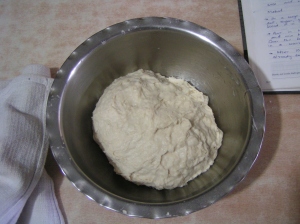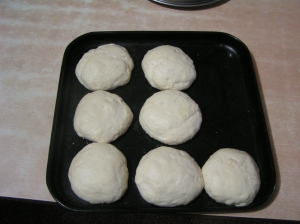So I woke up this morning with an absolute craving for this recipe I tried last week.And because I have stuffed myself full of salty-lemony goodness,I felt it’s only right to share this awesomeness with the world.
My dog doesn’t agree.She wants me to go for a walk when it’s raining.
Like this.
No,thank you.
I’d much rather surround myself with the delicious smell of bread baking.
Why yes..It really is this awesome.
And it is difficult to mess it up.A godsend really, given my penchant for simply forgetting to add ingredients.
Besides flour,which can be either all purpose or whole wheat…I’ve tried both and it works equally well,you need yeast,water,salt and…
Lemons!
Sea salt!
And the original recipe also includes rosemary but I decided to skip it cause I couldn’t wait.’
Sue me.
Lemon and Sea salt foccacia
Adapted from Girl versus dough
Note: The measures given here are half of the original recipe.
This gives 2 8-inch round loaves.
1tsp active dry yeast
2tbsps. Extravirgin olive oil
250 gms whole wheat flour
1tsp salt
2 lemons slices into thin rounds
coarse sea salt.
Method:
1.In a medium bowl, dissolve yeast with 1/4 cup lukewarm water; let stand 5 minutes until foamy. Add 3/4 cups lukewarm water and 2 tablespoons olive oil and stir.
2.In a large bowl , combine flour and salt. Add yeast mixture and stir with a wooden spoon until just combined. Knead dough on a lightly floured countertop until smooth, about 5 minutes. Shape dough into a ball and place in a large bowl with 2 tablespoons olive oil. Roll dough in oil and cover bowl lightly with plastic wrap. Let rise in a warm place until doubled, about 1 hour.
3.Brush 2 8-inch round cake pans and punch down dough. Spread dough with fingers to cover the entire inside bottom of cake pans. The dough might resist a bit, but with a little persistence it’ll start to behave. Cover with a damp towel and let rise until puffy, about 30-45 minutes.
4.Meanwhile, thinly slice some lemon and get out some coarse sea salt.
thinly slice some lemon and get out some coarse sea salt.
5. Preheat oven to 230C. Poke the puffy bread lightly with your fingertips to form dimples,then drizzle it with olive oil. Now top it with lemon slices and sea salt.
6.Bake bread until golden brown, about 20-30 minutes. Remove from oven and drizzle lightly with olive oil. Let cool slightly before slicing.
And then bask in the new found knowledge that you can eat,I mean, bake foccaccia without a problem.










